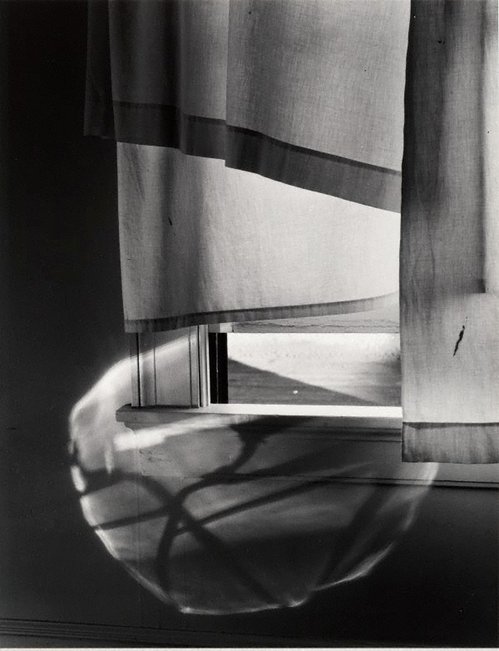Title
Dumb face, 72 N Union Street, Rochester, from the portfolio Sound of one hand 1960-1965
1959
Artist
-
Details
- Alternative title
- Dumb face, frost on window, January 12, 1959
- Date
- 1959
- Media category
- Photograph
- Materials used
- gelatin silver photograph mounted on card
- Dimensions
- 32.5 x 23.7 cm image/sheet
- Signature & date
Not signed. Not dated.
- Credit
- Gift of Patsy Asch 2005
- Location
- Not on display
- Accession number
- 118.2005.6
- Copyright
- Reproduced with permission of the Minor White Archive, Princeton University Art Museum. © Trustees of Princeton University.
- Artist information
-
Minor White
Works in the collection
- Share
-
-
About
Minor White's prestigious photographic career had a major impact on the development of photography in post war America. White believed in the spiritual qualities of photography; oriental philosophy, Zen, Gestalt psychology and the work of G. I. Gurdjieff were all to be important influences on his life and work. He spent much of his life promoting the work of others and, most importantly, advancing the notion of photography as art. White believed that photography should be akin to poetry: intensely personal and condensed moments of consequence.
White graduated with a degree in botany from the University of Minnesota in 1933 and became an active member of the Oregon Camera Club. His first solo exhibition was held at the Portland Art Museum in 1942. After being discharged from the United States Army Intelligence Corps in 1945 White moved to New York City where he studied aesthetics at Columbia University. During this time he worked for Beaumont and Nancy Newhall, met Alfred Stieglitz, Edward Weston and Paul Strand and worked as a photographer for the Museum of Modern Art. In 1946 he began teaching at the California School of Fine Arts which was supervised by Ansel Adams.
In 1952, White, Adams, Dorothea Lange, the Newhalls, Barbara Morgan and others established the influential 'Aperture' quarterly, which he edited. After organising the exhibition 'How to Read a Photograph' at the San Francisco Museum of Art, White began work as a curator at George Eastman House in Rochester where he remained for four years, curating exhibitions and editing 'Image Magazine'. In 1956 he began work at the Rochester Institute of Technology and started the significant and influential workshops which he would continue for the rest of his life. The Philadelphia Museum of Art organised a major solo traveling show of his work in 1970 and in the same year he was awarded a Guggenheim Fellowship.
White used sequences to extend the dialogue between images as well as between the artist and audience. As with most of White's images they are an abstract poetic response to an emotional connection with the subject. White believed in the photograph as metaphor, a concept that he first encountered in Alfred Stieglitz's 'Equivalents', and which he used as the basis for his work.
'The photographs in a sequence or constellation may be compared to dance on a theme. The major point or points of the whole are stated and restated with variations until the very last member of the audience has encountered it or them. Likewise the sequence must be long enough, either in number of photographs or time of study, to sustain the viewer until he has directly experienced the inner 'meaning' or 'manifestation' or Being. The viewer who is willing to bring his heart, mind, viscera and intuition to play upon a sequence will reach an understanding.' Minor White 1961
-
Exhibition history
Shown in 2 exhibitions
Flatlands: photography and everyday space, Art Gallery of New South Wales, Sydney, 13 Sep 2012–03 Feb 2013
Flatlands: photography & everyday space, Art Gallery of New South Wales, Sydney, 15 Sep 2012–03 Feb 2013
-
Bibliography
Referenced in 2 publications
-
Minor White, Minor White: rites & passages, 1978, (illus.).
-
Minor White, Mirrors, messages, manifestations, 1969, (illus.).
-




